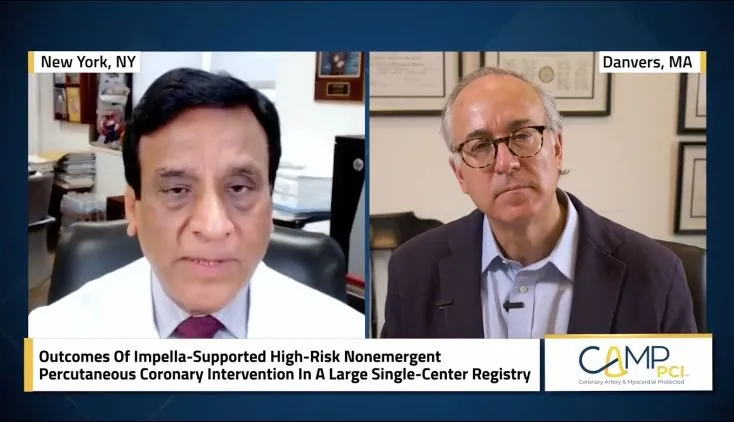Clinical Research & Data, Complete Revascularization, IABP, Protected PCI
Revascularization Completeness With pVAD vs IABP
York Data Analysis (Part I)
In a third-party analysis conducted by the York Health Economics Consortium, an independent research company owned by the University of York, individual patient data (IPD) from contemporary studies—PROTECT II randomized controlled trial, PROTECT III and RESTORE EF—was evaluated to test the hypothesis that percutaneous coronary intervention (PCI) with Impella® support may be associated with a greater extent of revascularization and, thus, may contribute to superior clinical outcomes compared to PCI of equivalent complexity utilizing intra-aortic balloon pump (IABP).
Vasileios Panoulas, MD, FRCP, PhD, FESC, a consultant interventional cardiologist at Royal Brompton and Harefield hospitals, presented the results of this analysis at EuroPCR 2023, the annual meeting of the European Association of Percutaneous Cardiovascular Interventions (EAPCI). Data for these patients included coronary artery disease severity measured pre-PCI using SYNTAX score and post-PCI using residual SYNTAX score (rSS). The analysis compared complete revascularization rates, defined as rSS<2, in high-risk PCI (HRPCI) patients who received Impella support (N=880) to HRPCI patients supported with IABP (N=155).
Results showed a 40% greater reduction in rSS with Impella versus IABP (95% CI 27-50%, p<0.001). Complete revascularization (rSS<2) was achieved in 42.2% of patient supported with Impella compared to 20.6% of patients supported with IABP. “When taking study limitations into account, this pooled analysis showcases the potential of Impella to contribute to improved long-term patient outcomes by allowing a greater extent and quality of revascularization,” Dr. Panoulas stated.
In a subgroup analysis of patients with left ventricular ejection fraction (LVEF) under 20%, complete revascularization rates in the Impella group remained around 40% whereas they dropped to 15% in the IABP group. In addition, 70% of patients in the Impella group achieved what is considered “acceptable results” with a residual SYNTAX score below 8, while only about 30% of patients in the IABP group achieved these results.
“In essence we have seen that if you combine all these datasets, approximately twice as many patients achieved complete revasc with [p]VADs, such as Impella [...]"
Key Points and Take Aways
- Results showed a 40% greater reduction in rSS with Impella Protected PCI versus IABP (95% CI 27-50%, p<0.001).
- Complete revascularization (rSS<2) was achieved in 42.2% of Impella patients compared to 20.6% of IABP patients.
- In a subgroup analysis of patients with left ventricular ejection fraction (LVEF) under 20%, complete revascularization rates in the Impella group remained around 40% whereas they dropped to 15% in the IABP group.
- 70% of patients in the Impella group achieved “acceptable results” (rSS<8), while only about 30% of patients in the IABP group achieved these results.
- “When taking study limitations into account, this pooled analysis showcases the potential of Impella to contribute to improved long-term patient outcomes by allowing a greater extent and quality of revascularization.”
NPS-3776


